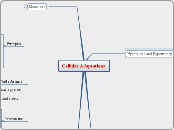Cellular Adaptations
Atrophy
Cell aging
Reduced nutrient/O2 supply
Pressure
Loss of neurological/hormonal stimulation
Decreased workload
Physiologic
Uterus after parturition
Loss of embryonic structures
Notochord
Thyroglossal duct
Occurs during normal development
Cell death may occur when atrophy progress to cellular injury
Increased degradation via
Ubiquitin-proteosome pathway
Lysosomes
Shift in balance of protein synthesis and degradation
New equilibrium achieved by decreasing cell volume in relation to reduced nutrient supply
Retreat by cell to a smaller size where survival is possible
Shrinkage of cell size by loss of cell substance
Diminished function
Metaplasia
Examples
Strat Squamous to Columnar
Barrett's Esophagus
Predisposition to adenocarcinoma of esophagus
Squamous Epithelium replaced by intestinal-like columnar cells
Due to chronic GERD
Columnar to Stratified Squamous
May predispose to neo-plastic change if persistant
SCCarcinoma
Improved survival
Protective mechanism of mucus secretion lost
Stones in excretory ducts of exocrine glands
Chronic irritation caused by cigarettes
Most common epithelial metaplasia
Mechanisms
Signals generated by cytokines, GFs and ECM components
Precursor differentiate along a new pathway
Reprogrammin of undifferentiated cells in tissue
Connective Tissue
E.g. Myositis ossificans
Bone formation in muscle, usually after fracture
Less clearly seen as adaptive change
Formation of mesenchymal tissues in tissues that do not contain these elements
Epithelial
Often predisposes cell to neoplastic change
Adaptive substitution of cells sensitive to stress by cell types better able to survive adverse environment
Reversible change in which one cell type is replaced by another
Concept
Reversible process
Ohysiologic or pathologic
State of between normal unstressed cell and overstressed injured cell
Hyperplasia and Hypertrophy
Pathologic
Chronic Overload
Overtime hypertrophy exhausts organ's ability to compensate
Organ failure
Glomerular hyperplasia in renal failure
Cariomegaly in chronic hypertension
Excess Growth Factor stimulation
Predisposes to carcinogenesis
Benign prostatic hyperplasia
Keloids
Endometrial hyperplasia
Common
Triggers
Mechanical Factors
Mechanical load in long bones causes hypertrophy of bone
Hormonal Triggers
Increase in size of thyroid gland due to excess TSH
Proliferation of Endometrium during menstrual cycle
Increased Functional Demand
Regeneration of injured liver
Myocardial hypertrophy in chronic hemodynamic overload
Muscular Hypertrophy of Bodybuilders
Hypertrophy
Non dividing cells can only hypertrophy
Myocardial Cells
Increase in size of cells leading to increase in size of organ
Hyperplasia
Only in cells capable of dividing
Increase in no. of specialized cells in an organ

